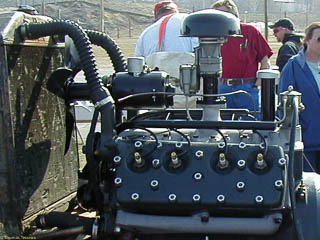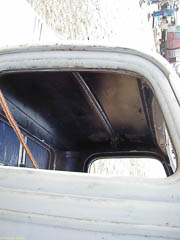Early Ford V8 Swap Meet--Fitchburg, MA, April 22, 2001
This Model A has been done with a stock 21-stud 1937/1938 engine. The water outlets are in the center of the heads, but there are only 5 studs on the bottom of the heads. The water pumps are mounted on the front of the block. These
heads are the least common style. Not much else on the engine is stock: it looks like a high rise Thickstun intake with two carburetors (Strombergs, I think, but I'm not so good at telling the difference between Strombergs
and Holleys from this side). The distributor is a modern Mallory crab-cap style. Fenton headers. The owner must be adventurous because he's plumbed in a heater (one hose coming off the right hand head and the other hose coming
out of the firewall). I assume he's from down under with that overflow can for the radiator.
I got this e-mail recently:
Tom,
While surfing the web last night I came across your web site. To my surprise and pleasure, I noticed my flathead engine on your opening page. I was trying to figure where it was taken until I clicked on the Fitchburg 2001 link.
My wife and I had driven up from the Cape early that morning. I had to run the heater all the way up as it was quite cold at 5 AM when we started out.
For the ride home we stowed the curtains and dropped the top as the temp had climbed to near 80 degrees.
You hit all the details about the engine right on. I currently have another 21 stud being built by Ron Holleran in Vermont. This new engine will be bored to 239 cu. in. with a hotter cam and some modifications to the combustion chambers. It should be done for the summer cruising season.
I plan to drive up to Fitchburg again this year as long as the roads are dry.
Hope to get to talk to you then.
Paul Howard
Attached is a LH shot of the engine showing that they are Stromberg carbs.
No word about the Foster's can though... :-)
1932 or 1933 Flathead V8 on display stand
There were two complete engines running on test stands. This is an early 21-stud engine -- probably 1932. I'm basing this on the very tall ignition coil, the water pump castings (which look like Model A water pumps), the
carburetor (Ford went to Stromberg carburetors in 1934) and also the fuel pump. You can see the intake manifold has a crankcase breather in front of the fuel pump. In 1934, the fuel pump was mounted to the side of the
breather pipe.
V8 60 Engine on display stand
The other engine on display was the smaller 60 horsepower V8 with 136 cubic inches. This is in comparison to 85 horsepower and 221 cubic inches for the larger Ford V8's. The V8 60 was made from 1937 to about 1940. These
engines were very popular for putting in midget racers. The racer shown is part of the collection at the Collings Foundation in Stow, Massachusetts.
1935 and 1936 Truck Cabs
These were lying face up on a trailer. I've rotated the pictures to try to get a more normal orientation, but the angles are a bit weird. And the cars and people floating in the background adds to the vertiginous feeling.
The 1935 cab is on the left; the 1936 cab on the right. The difference (besides the extra rust on this 1935) is that the "A" pillar on the 1935 meets the cowl at an angle, while this is curved slightly on the 1936 truck cab.
If you look inside the cab, the 1935 has two reinforcing ribs across the top of the cab while the 1936 has only one reinforcing rib.
1940 Coupe
With the hood down, this would look bone stock. Still, the 5 window coupe looks sporty as is. Under the hood this engine has way more than 85 horses. I'm most surprised that he still has a six volt battery. It's not as if he has an original
McCulloch supercharger on it.
1940 Sedan
From a distance, this looks almost like gray primer, but in the picture with the engine you can see that it's painted. Nicely done accessories for the engine. Since the pinstriping is under the hood, I guess the
owner is trying to keep it look bone stock on the outside. It stands to reason that not everyone could afford wide whitewall tires back then.
Whole lotta carbs...
My engine is probably over-carbed with two, and lots of three carb manifolds only hook up one or two carburetors or have a progressive linkage. But four! I overheard someone say that these were intended for all out racing with alcohol
as a fuel. Alcohol runs higher compression without knocking (like high octane fuel), but has less energy per weight or volume, so you need to burn more of it.



















